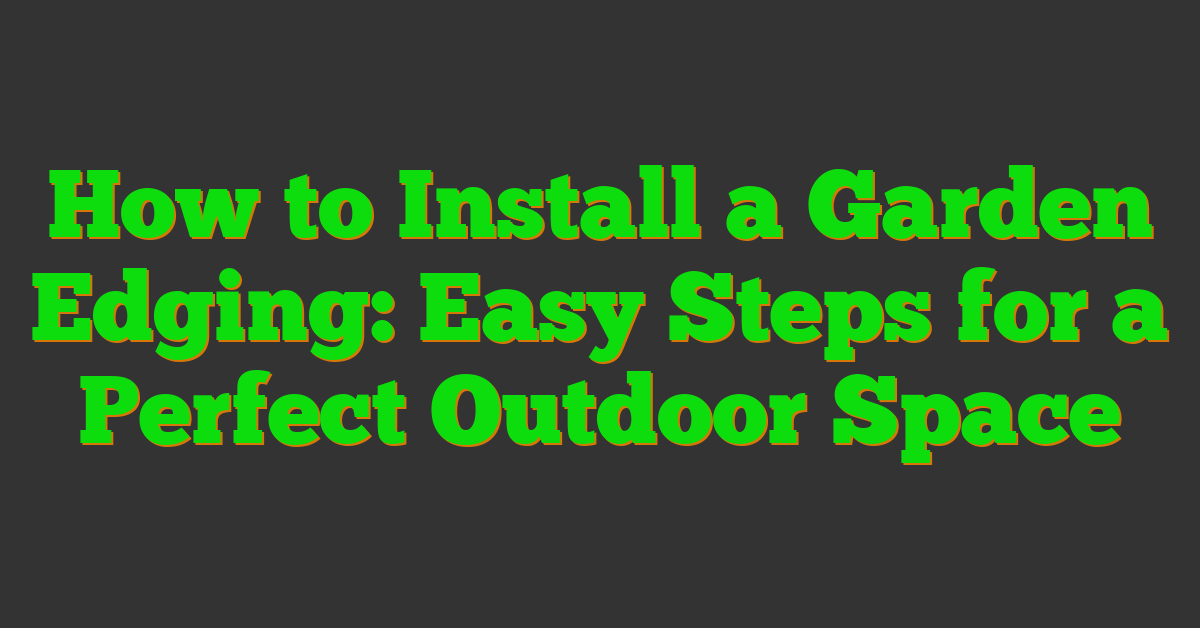Creating a beautiful garden starts with the details, and installing garden edging is one of those simple touches that can make a big difference. I’ve found that the right edging not only defines your garden beds but also adds a polished look to your outdoor space.

Whether you’re a seasoned gardener or just starting out, laying down garden edging is easier than you might think. In this guide, I’ll walk you through the steps to help you achieve a neat and well-organized garden that you’ll be proud of.
Types Of Garden Edging
- Metal Edging: Provides a clean, sleek boundary. Steel and aluminum varieties offer durability and a modern look.
- Plastic Edging: Lightweight and flexible, suitable for curved garden beds. Resistant to moisture and easy to install.
- Brick or Stone Edging: Offers a natural, timeless appearance. Ideal for traditional garden styles and provides long-lasting structure.
- Timber Edging: Adds a rustic touch. Treated wood resists rot and can be shaped to fit various garden designs.
- Concrete Edging: Sturdy and versatile. Can be molded into different shapes and patterns to match the garden’s aesthetic.
Tools And Materials Needed
I gather the necessary tools and materials for a successful garden edging installation.
Measuring And Marking
I measure the area to ensure precise edging placement. I use a measuring tape to mark the desired path and set stakes at regular intervals. I connect the stakes with string to outline the edging area.
Preparing The Site
I prepare the site by removing existing grass or weeds. I dig a trench 2-3 inches deep along the marked path using a shovel. I level the trench to create a stable base for the edging material.
Installation Steps
Installing garden edging involves specific steps depending on the material you choose. Below are detailed procedures for installing plastic and metal edging.
Installing Plastic Edging
Begin by aligning the plastic edging along the prepared trench. Ensure it follows the marked path accurately. Next, secure the edging with plastic stakes placed every 12 inches to maintain stability. Adjust the edging to keep it level and straight, making minor tweaks as needed. Finally, backfill the trench with soil, covering the edging while maintaining its position. This method provides a flexible and durable boundary for your garden beds.
Installing Metal Edging
Start by positioning the metal edging into the trench, ensuring it matches the desired layout. Hammer metal stakes into the ground at 18-inch intervals to hold the edging firmly in place. Use a rubber mallet to tap the edging down, ensuring it sits evenly with the soil surface. Check for alignment and make adjustments to keep the edging straight. Once satisfied with the placement, backfill the trench with soil, freezing the edging securely. Metal edging offers a sleek, long-lasting edge that enhances the garden’s appearance.
Maintenance Tips
- Regular Cleaning: I remove leaves, dirt, and debris around the edging to keep it looking sharp and prevent buildup that can cause damage.
- Inspect for Damage: I examine the edging monthly for cracks, bends, or displacement, addressing any issues immediately to maintain its integrity.
- Weed Control: I manage weeds by trimming them at the base and using mulch to reduce growth around the edging, ensuring a tidy garden border.
- Reinforce Stability: I check the stakes or anchors securing the edging, tightening or replacing them as needed to ensure the edging stays in place.
- Adjust After Seasons: I realign the edging after heavy rains or harsh winters, as soil movement can cause shifts that affect the edging’s appearance and function.
- Protect Materials: I apply protective treatments to metal or wood edging, such as rust inhibitors or sealants, to extend their lifespan and maintain their appearance.
- Replace Worn Sections: I swap out any damaged or worn parts of the edging, ensuring the entire border remains uniform and effective in defining garden beds.
Common Mistakes To Avoid
- Improper Trench Depth
Digging the trench too shallow or too deep affects the edging’s stability. I maintain a depth of 2-3 inches to ensure a secure base.
- Inconsistent Alignment
Misaligned edging disrupts the garden’s flow. I use a string line to keep the edging straight and uniformly placed.
- Insufficient Securing
Failing to anchor the edging properly can lead to shifting. I stake the edging at regular intervals to maintain its position.
- Neglecting Base Preparation
A loose or uneven base can cause the edging to wobble. I compact the soil in the trench before installing the edging material for added stability.
- Choosing Inappropriate Materials
Selecting edging materials that don’t suit the garden’s needs can reduce effectiveness. I opt for materials that match my garden’s design and durability requirements.
- Ignoring Water Drainage
Poor drainage around the edging can lead to material degradation. I ensure proper drainage by grading the soil away from the edging or adding drainage elements as needed.
- Overlooking Maintenance Needs
Neglecting regular upkeep can compromise the edging’s appearance and functionality. I schedule routine inspections and cleanings to keep the edging in optimal condition.
- Skipping Measurements
Inaccurate measurements can result in wasted materials and uneven installation. I double-check all measurements before starting the installation to ensure precision.
- Forgetting to Remove Weeds
Allowing weeds to grow around the edging can undermine its structure. I remove all existing weeds and apply a weed barrier before installing the edging to prevent future growth.
- Rushing the Installation Process
Hurrying through installation can lead to mistakes and shortcuts. I take my time to follow each step carefully, ensuring a high-quality and lasting garden edging.
Conclusion
Working on garden edging was a rewarding experience for me. Seeing the clear lines it created made my garden look organized and beautiful.
« Saving on DIY Landscaping Projects: 10 Tips to Reduce Costs Mulching Benefits and How to Do It Right: Ultimate Guide for a Thriving Garden »
You have all the tools and knowledge to get started. Taking the time to plan and install your edging properly will pay off with a stunning outdoor space you can enjoy for years.
Happy gardening!
















